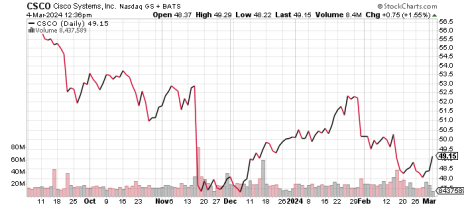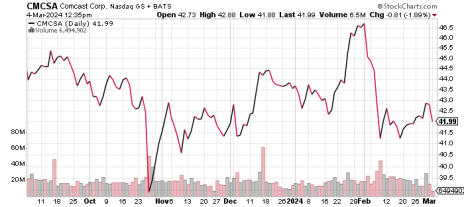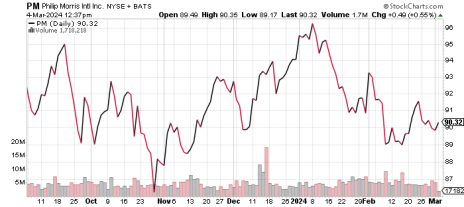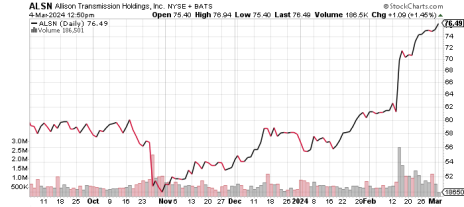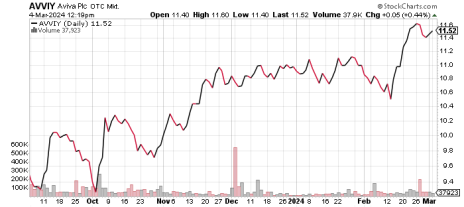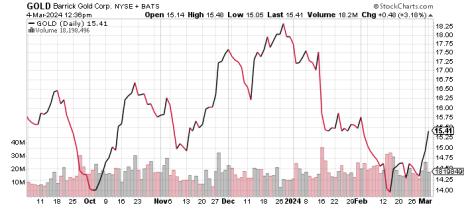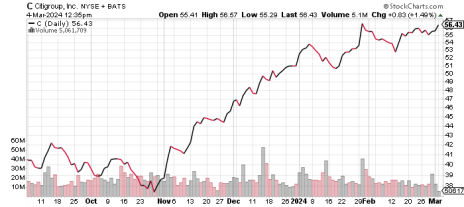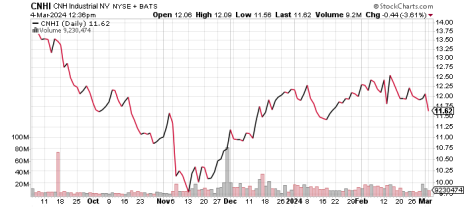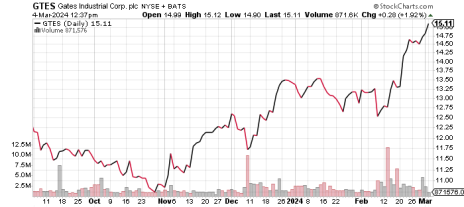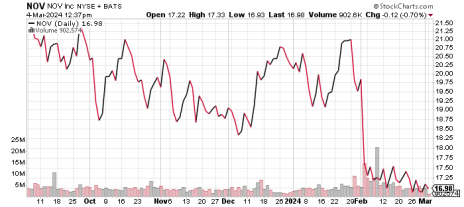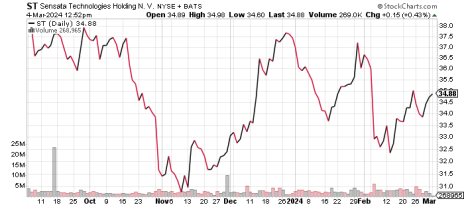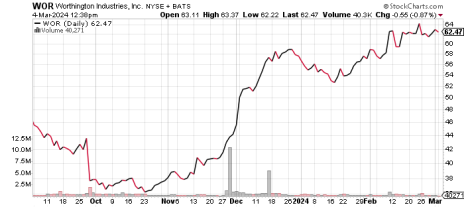Poker and Value Investing
In the academic world, all stocks are viewed as interchangeable. The only difference is their risk, as defined by their volatility. Thus, if all stocks are the same, other than their volatility, then of course the market is highly efficient and an indexing strategy is the only logical choice for one’s capital.
But this view is flawed – all stocks are not the same. Each stock is an ownership share of a real, underlying company, and no company is exactly the same as any other. Even those that operate in the same industry are different from each other – while they may ride the same general fundamental trends, their strategies, managements, execution, capital structures and other traits have differences that can add up over time.
Another flaw is the academic assumption that all investors buy and sell equal amounts of a stock at the same time. A different way of saying this is that the theory factors in no differences in position sizes – all positions are viewed as having an unchanged weighting (other than perhaps those driven by changes in a company’s market capitalization). This doesn’t make any sense in reality. As a former colleague explained to me long ago, “It doesn’t matter what you own, it matters how much you own of what.” Weighting and position sizes matter.
An analogy can be found in poker. Over the course of an evening, all of the players get essentially the same quality of hands dealt to them. An academic might say that the odds of winning are the same for everyone, and essentially random at that. But, invariably, one player is a big winner, several are incrementally ahead/behind, and someone else is a big loser. Why? Because each player bets their specific hands differently. Savvy card players bet more heavily the more the odds move in their favor and bet less heavily as the odds become unfavorable – raising at times and folding at other times. It would make no sense to stay all the way through every hand, nor would it make sense to not bet aggressively when holding a winning hand.
Value investing is much the same. The experienced value investor uses a combination of fundamentals (the quality of their poker hand) and valuation (think of this as the upside from the current stock price, analogous to the size of the pot) to help determine their position sizing. These position sizes may change significantly over the course of a holding period, increasing when the share price inexplicably tumbles and decreasing as the share price goes up. While I’ve seen it practiced at the institutional fund management level, it would make no sense to hold equal sizes of every stock owned.
The academic view has its merits, but value investors can play the game differently – to win.
Share prices in the table reflect Monday, March 4 closing prices. Please note that prices in the discussion below are based on mid-day March 4 prices.
Note to new subscribers: You can find additional color on past earnings reports and other news on recommended companies in prior editions and weekly updates of the Cabot Value Investor on the Cabot website.
Send questions and comments to Bruce@CabotWealth.com.
Today’s Portfolio Changes
None.
Portfolio Changes Since Last Month
Allison Transmission (ALSN) – Moving shares from Hold to Sell.
Sensata Technologies (ST) – Moving the shares from Hold to Sell.
Upcoming Earnings Reports
Thursday, March 7: Aviva plc (AVVIY)
Friday, March 22: Worthington Enterprises (WOR)
Growth & Income Portfolio
Growth & Income Portfolio stocks are generally higher-quality, larger-cap companies that have fallen out of favor. They usually have some combination of attractive earnings growth and an above-average dividend yield. Risk levels tend to be relatively moderate, with reasonable debt levels and modest share valuations.
| Stock (Symbol) | Date Added | Price Added | 3/4/24 | Capital Gain/Loss | Current Dividend Yield | Price Target | Rating |
| Cisco Systems (CSCO) | 11/18/20 | 41.32 | 49.21 | 19.10% | 3.30% | 66 | Buy |
| Comcast Corp (CMCSA) | 10/26/22 | 31.5 | 41.97 | 33.20% | 3.00% | 46 | Hold |
| Philip Morris International (PM) | 9/18/23 | 96.96 | 90.25 | -6.90% | 5.80% | 120 | Buy |
| Stock (Symbol) | Current price | 2024 EPS Estimate | 2025 EPS Estimate | Change in 2024 Estimate | Change in 2025 Estimate | P/E 2024 | P/E 2025 |
| CSCO | 48.95 | 3.76 | 3.88 | 0.0% | 0.0% | 13.0 | 12.6 |
| CMCSA | 42.11 | 4.26 | 4.63 | 0.0% | 0.0% | 9.9 | 9.1 |
| PM | 89.59 | 6.40 | 7.04 | 0.0% | 0.0% | 14.0 | 12.7 |
Cisco Systems (CSCO) is facing revenue pressure as customers migrate to the cloud and thus need less of Cisco’s equipment and one-stop-shop services. Cisco’s prospects are starting to improve under a relatively new CEO, who is shifting Cisco toward a software and subscription model and is rolling out new products, helped by its strong reputation and entrenched position within its customers’ infrastructure. The company is highly profitable and generates vast cash flow. Its announced deal for Splunk will drain most of its cash hoard but we see this as being replenished relatively quickly.
On February 14, Cisco reported an average quarter but forward guidance was weak as the revenue slowdown rolls on. Adjusted earnings of $0.87/share fell 1% but were 4% above estimates. Revenues fell 6% but were in line with estimates. Fiscal third-quarter and full-year guidance was cut as demand, notably by telecom and cloud customers (and, geographically, Asia Pacific/Japan) remains weak.
Cisco said that customers continue to digest their aggressive purchases from prior quarters. One lingering problem, though, is that demand appears to be weakening for cyclical reasons, as businesses pull back in general on tech spending. Cisco’s 12% drop in new orders only adds to this concern although the comparison was against strong order growth a year ago. And, despite the fall-off in new orders, the backlog continues to move upward.
The gross margin expanded to 66.7% from 63.9%, continuing the sharp improvement we saw a quarter ago in what appears to be a permanent step-up. Higher expenses weighed on operating profits, which fell 5%. The company is cutting 5% of its workforce to adjust. Cisco’s share count fell as it repurchased $1.3 billion of its shares in the quarter. The balance sheet is cash-heavy but most of this cash will vanish with its purchase of Splunk, assuming the deal is approved by regulators. The company raised its quarterly dividend by 1 cent, to $0.40/share.
On February 27, Splunk reported a strong quarter, with revenues increasing 19% and adjusted operating income rising 50%. Both results were above consensus estimates. Adjusted free cash flow rose 56% to $418 million. Overall, the report was encouraging in advance of Cisco’s acquisition of Splunk.
Cisco shares remain attractive given their reasonable valuation and the company’s strong cash flow production. But we are incrementally wary that the business cycle is turning against Cisco. For now, we will stay the course with our Buy rating.
CSCO shares rose 1% in the past week and have 35% upside to our 66 price target. Based on 2024 estimates, unadjusted for the Splunk acquisition, the valuation is reasonably attractive at 9.3x EV/EBITDA and 13.0x earnings per share. BUY
Comcast Corporation (CMCSA) – Comcast is one of the world’s largest media and entertainment companies. Its properties include Comcast cable television, NBCUniversal (movie studios, theme parks, NBC, Telemundo and Peacock), and Sky media. The Roberts family holds a near-controlling stake in Comcast. Comcast shares have tumbled due to worries about cyclical and secular declines in advertising revenues and a secular decline in cable subscriptions as consumers shift toward streaming services, as well as rising programming costs and incremental competitive pressure as phone companies upgrade their fiber networks.
However, Comcast is a well-run, solidly profitable and stable company that will likely continue to successfully fend off intense competition while increasing its revenues and profits, as it has for decades. The company generates immense free cash flow which is more than enough to support its reasonable debt level, generous dividend and sizeable share buybacks.
There was no significant company-specific news in the past week.
Comcast shares were unchanged in the past week and have 9% upside to our 46 price target. HOLD
Philip Morris International (PM) – Based in Connecticut, Philip Morris owns the global non-U.S. rights to sell Marlboro cigarettes, the world’s best-selling cigarette brand. Cigarettes comprise about 65% of PMI’s revenues. The balance of its revenues is produced by smoke-free tobacco products. The cigarette franchise produces steady revenues and profits while its smoke-free products are profitable and growing quickly. The upcoming full launch of IQOS products in the United States, a wider launch of the IQOS ILUMA product and the recent $14 billion acquisition of Swedish Match should help drive new growth.
The company is highly profitable, generates strong free cash flow and carries only modestly elevated debt (at about 3.2x EBITDA) which it will whittle lower over the next few years. The share valuation at about 13.5x EBITDA and 15.6x per-share earnings is too low in our view. Primary risks include an acceleration of volume declines and/or deteriorating pricing, higher excise taxes, new regulatory or legal issues, slowing adoption of its new products, and higher marketing costs. A strong U.S. dollar will weigh on reported results. While unlikely, Philip Morris could acquire Altria, thus re-uniting the global Marlboro franchise.
On February 8, Philip Morris Intl reported a reasonable quarter, with adjusted earnings of $1.36/share which increased 12% but fell 6% shy of the consensus estimate of $1.45/share.
Revenues grew 11% (or, 8% excluding the Swedish Match acquisition, currencies and other inorganic changes) and were in line with estimates. Cigarette and heated tobacco unit volumes fell (0.5)% but were better than the (1.9)% industry decline and much better than the (5)% or more decline in the United States (which is outside of PMI’s market). PMI’s cigarette/HTU products gained incremental market share. Impressively, the company increased prices by 9% for the full year – this pricing power is key to the PMI story. Revenue and margin growth, however small, are key to investor perceptions that the company won’t fade away. IQOS growth was strong with 1.2 million new users added in the quarter.
While revenues were healthy, the operating margin fell by 2.8 percentage points. Higher pricing was more than offset by higher manufacturing and overhead costs. Excluding currency changes and the effects of acquisitions, PMI said its margin fell only 0.1 percentage point. However, the margin includes a dizzying number of adjustments which make clean comparisons murky despite the detail provided.
PMI is making progress with its transition to smoke-free products, helped considerably by its acquisition of Swedish Match. The IQOS product revenues now exceed Marlboro revenues, while 40% of gross profits are produced by smoke-free products.
Swedish Match continues to be a bit of a gem, as revenues grew 20% (organic) for this newly acquired business, and as its profits are ahead of PMI’s targets.
Guidance for 2024 and for the 2024-2026 period were for more of the same: positive shipment volume growth, 6-8% revenue growth, 8-10% operating profit growth. However, the guidance for 2024 was incrementally below current estimates.
There was no significant company-specific news in the past week.
PMI’s shares fell 1% in the past week and have 34% upside to our 120 price target. The shares offer an attractive 5.8% dividend yield. BUY
Buy Low Opportunities Portfolio
Buy Low Opportunities Portfolio stocks include a wide range of value opportunities. These stocks carry higher risk than our Growth & Income stocks yet also offer more potential upside. This group may include stocks across the quality and market cap spectrum, including those with relatively high levels of debt and a less-clear earnings outlook. The stocks may not pay a dividend. In all cases, the shares will trade at meaningful discounts to our estimate of fair value.
| Stock (Symbol) | Date Added | Price Added | 3/4/24 | Capital Gain/Loss | Current Dividend Yield | Price Target | Rating |
| Allison Transmission Hldgs (ALSN) | 2/23/22 | 39.42 | 71.75 | 82.00% | 1.30% | 59 | Sell |
| Aviva (AVVIY) | 3/3/21 | 10.75 | 11.56 | 7.50% | 7.30% | 14 | Buy |
| Barrick Gold (GOLD) | 3/17/21 | 21.13 | 15.42 | -27.00% | 2.60% | 27 | Buy |
| Citigroup (C) | 11/24/21 | 67.28 | 56.41 | -16.20% | 3.80% | 85 | Buy |
| CNH Industrial (CNHI) | 11/30/23 | 10.74 | 11.62 | 8.20% | 3.40% | 15 | Buy |
| Gates Industrial Corp (GTES) | 8/31/22 | 10.72 | 15.08 | 40.70% | 0.00% | 16 | Buy |
| NOV, Inc (NOV) | 4/25/23 | 18.19 | 16.99 | -6.60% | 1.20% | 25 | Buy |
| Sensata Technologies (ST) | 2/17/21 | 58.57 | 32.74 | -44.10% | 1.50% | 57 | Sell |
| Worthington Enterprises (WOR) | 2/6/24 | 57.13 | 62.5 | 9.40% | 1.00% | 73 | Buy |
| Stock (Symbol) | Current price | 2024 EPS Estimate | 2025 EPS Estimate | Change in 2024 Estimate | Change in 2025 Estimate | P/E 2024 | P/E 2025 |
| AVVIY | 11.55 | 0.44 | 0.49 | 0.0% | 0.0% | 26.2 | 23.5 |
| GOLD | 15.31 | 0.94 | 1.11 | -0.4% | -0.4% | 16.3 | 13.8 |
| C | 56.31 | 5.97 | 7.11 | 0.0% | 0.0% | 9.4 | 7.9 |
| CNHI | 11.82 | 1.56 | 1.59 | -0.1% | -0.4% | 7.6 | 7.4 |
| GTES | 14.95 | 1.38 | 1.60 | 0.1% | 0.3% | 10.8 | 9.4 |
| NOV | 17.08 | 1.52 | 1.84 | 0.7% | 1.2% | 11.3 | 9.3 |
| WOR | 62.67 | 3.47 | 3.56 | na | na | 18.1 | 17.6 |
Allison Transmission Holdings, Inc. (ALSN) – Allison Transmission is a midcap manufacturer of vehicle transmissions. While many investors view this company as a low-margin producer of car and light truck transmissions that is destined for obscurity in an electric vehicle world, Allison actually produces no car or light truck transmissions. Rather, it focuses on the school bus and Class 6-8 heavy-duty truck categories, where it holds an 80% market share. Its EBITDA margin is sharply higher than its competitors and on par with many specialty manufacturers. And, it is a leading producer and innovator in electric axles which all electric trucks will require. The company generates considerable free cash flow and has a low-debt balance sheet. Its capable leadership team keeps its shareholders in mind, as the company has reduced its share count by 38% in the past five years.
On February 13, Allison reported strong results which set company records. Adjusted earnings of $1.91/share increased 26% and were 31% above the consensus estimate. Sales grew 8% and were 4% above estimates. Adjusted EBITDA of $277 million increased 13% and was 10% above estimates. The quarterly results capped similarly strong full-year results. For 2024, management guided for a repeat of 2023 – encouraging, as many were expecting a weaker year.
In the quarter, strong demand for highway trucks in North America (sales up 14%) generated most of the growth in total revenues, but demand in most of the company’s segments remained reasonably healthy. The gross margin expanded as volumes and price increases more than offset higher direct material costs. Overhead expenses fell, helping to boost profits further. Free cash flow of $186 million (a remarkably satisfying 24% of revenues) rose 41%. The balance sheet continues to be sturdy.
Allison repurchased about 6% of its shares in 2023 while also paying a generous (and increased) quarterly dividend of $0.23/share.
On February 15, we moved the shares from Hold to Sell. The strong earnings report and encouraging 2024 outlook drove the shares up 15% to over 70, well above our prior 59 price target. Even when updating our model with optimistic assumptions, the shares look fully valued at 70.
Allison remains a fundamentally strong company with a valuable market position, healthy profits and robust free cash flow, backed by a solid balance sheet. The management team is among the best in the industrial sector for its operational oversight and shareholder-friendly philosophy. We would readily repurchase shares at lower prices.
Since inception on February 23, 2022, the recommendation produced an 82% total return. This compares to an estimated 22% total return for the S&P 500 Index over the same period. SELL
Aviva, plc (AVVIY), based in London, is a major European company specializing in life insurance, savings and investment management products. Amanda Blanc, hired as CEO in July 2020, is revitalizing Aviva’s core U.K., Ireland and Canada operations following her divestiture of other global businesses. The company now has excess capital which it is returning to shareholders as likely hefty dividends following a sizeable share repurchase program. While activist investor Cevian Capital has closed out its previous 5.2% stake, highly regarded value investor Dodge & Cox now holds a 5.0% stake, providing a valuable imprimatur and as well as ongoing pressure on the company to maintain shareholder-friendly actions.
Aviva reports second-half 2023 results on Thursday, March 7. We anticipate an update on the company’s capital return program, including a likely increase in the recurring dividend.
Aviva shares fell 1% in the past week and have 21% upside to our 14 price target. Based on management’s guidance for the 2023 full-year dividend, which we believe is a sustainable base level, the shares offer a generous 7.3% yield. We anticipate a dividend increase for 2024. On a combined basis, the dividend and buybacks offer more than a 10% “shareholder yield” to investors. BUY
Barrick Gold (GOLD), based in Toronto, is one of the world’s largest and highest-quality gold mining companies. About 50% of its production comes from North America, with the balance from Africa/Middle East (32%) and Latin America/Asia Pacific (18%). Barrick will continue to improve its operating performance (led by its highly capable CEO), generate strong free cash flow at current gold prices, and return much of that free cash flow to investors while making minor but sensible acquisitions. Also, Barrick shares offer optionality – if the unusual economic and fiscal conditions drive up the price of gold, Barrick’s shares will rise with it. Given their attractive valuation, the shares don’t need this second (optionality) point to work – it offers extra upside. Barrick’s balance sheet has nearly zero debt net of cash. Major risks include the possibility of a decline in gold prices, production problems at its mines, a major acquisition and/or an expropriation of one or more of its mines.
On February 14, Barrick reported a reasonable quarter, with earnings of $0.27/share increasing 13% from a year ago and coming in 23% above the $0.22 estimate.
However, the company’s progress, best illustrated by its full-year results, remains sloppy. Free cash flow rose 50%, but this was compared to a small $432 million base and was due entirely to lower taxes and higher interest income on its cash balances. Net debt, while small, continues to tick higher. Gold production fell 2% for the year – this is a lingering issue for Barrick’s management and shareholders. The company touts its “peerless asset portfolio” but can’t seem to boost production despite more capital spending (+27% over the past two years). Higher gold prices are being offset by higher costs. In many ways, Barrick isn’t benefiting from higher gold prices, it is getting bailed out by them. This is not helping our investment thesis.
For now, we are retaining our position in Barrick Gold but remain interested in swapping it for a higher-quality gold producer.
Over the past week, commodity gold jumped 3% to $2,111/ounce, a record high. Gold is holding its $2,000+ pricing despite what is increasingly becoming a higher-for-longer U.S. interest rate environment.
Our view on gold prices avoids most of these technicals and is based on what we believe is a structural upshift in inflation. These changes include war, government spending, crime, oil prices and past-the-peak fading of the benefits of global free trade, in addition to a tight labor market. There is a reasonably good chance that inflation will remain above a 3% pace indefinitely. This would imply permanent 4-6% interest rates. Recent comments by the Fed suggest that rate cuts are increasingly unlikely in the near term.
The 10-year Treasury yield ticked down to 4.23%. The U.S. Dollar Index (the dollar and gold usually move in opposite directions) was unchanged at 103.77.
Investors and commentators offer a wide range of outlooks for the economy, interest rates and inflation. We have our views but hold these as more of a general framework than a high-conviction posture. Investing in gold-related equities is a long-term decision – investors shouldn’t allow near-term weakness to deter their resolve.
Barrick shares rose 5% in the past week and have 76% upside to our 27 price target. The shares remain depressed despite gold prices above the $1,800 - $2,000 range, indicating that investors have no confidence in gold prices and little confidence in the company’s ability to generate higher cash flow. BUY
Citigroup (C) – Citi is one of the world’s largest banks, with over $2.4 trillion in assets. The bank’s weak compliance and risk-management culture led to Citi’s disastrous and humiliating experience in the 2009 global financial crisis, which required an enormous government bailout. The successor CEO, Michael Corbat, navigated the bank through the post-crisis period to a position of reasonable stability. Unfinished, though, is the project to restore Citi to a highly profitable banking company, which is the task of new CEO Jane Fraser. Investors have lost hope in Citigroup, creating an impressive bargain.
There was no significant company-specific news in the past week.
Citi shares rose 2% in the past week and have 51% upside to our 85 price target. The shares have rebounded 45% since touching their 3-year low last October, reinforcing the importance for investors to focus on valuation and fundamentals rather than the share price.
The stock remains attractive as it trades at about 65% of tangible book value of $86.19. The dividend offers investors a 3.8% yield. BUY
CNH Industrial (CNHI) – This company is a major producer of agriculture (80% of sales) and construction (20% of sales) equipment and is the #2 ag equipment producer in North America (behind Deere). Its shares have slid from their peak and now trade essentially unchanged over the past 20 years. While investors see an average cyclical company at the cusp of a downturn, with a complicated history and share structure, we see a high-quality and financially strong company that is improving its business prospects and is simplifying itself yet whose shares are trading at a highly discounted price. See our November 30 Alert and the December 5 Monthly letter for more color on our thesis.
On February 14, the company reported a good quarter, with adjusted earnings of $0.42/share increasing 17% and matching the consensus analyst estimate. Revenues fell 2% and were 1% below estimates.
The company continues to make progress with its efficiency initiatives as part of its full separation from its Iveco and other operations, and as it upgrades its technology offerings to boost the relevance and value of its “iron” to farmers and the construction trades. In the quarter, industrial operating margins expanded by 90 basis points (100 basis points equals one percentage point), with improvements in both the agriculture and construction segments. Wider gross margins, helped by higher prices and lower costs, helped drive operating margins higher. Financial segment profits were healthy and backed by strong credit quality.
CNH provided a subdued outlook for 2024, with industrial revenues guided to decline about 10% and overall company earnings per share guided to decline about 9%. The earnings guidance was roughly in line with analysts’ estimates while sales guidance was below estimates. Cyclical end-market demand trends remain the weak link in the near term while internal improvements will help support profits until the cycle turns up.
The balance sheet remains strong and is supported by healthy free cash flow. All in, an incrementally encouraging report.
There was no significant company-specific news in the past week.
CNH’s shares fell 2% in the past week and have 27% upside to our 15 price target. The 3.3% dividend yield offers a reasonable interim cash return. BUY
Gates Industrial Corp, plc (GTES) – Gates is a specialized producer of industrial drive belts and tubing. While this niche might sound unimpressive, Gates has become a leading global manufacturer by producing premium and innovative products. Its customers depend on heavy-duty vehicles, robots, production and warehouse machines and other equipment to operate without fail, so the belts and hydraulic tubing that power these must be exceptionally reliable. Few buyers would balk at a reasonable price premium on a small-priced part from Gates if it means their million-dollar equipment keeps running. Even in automobiles, which comprise roughly 43% of its revenues, Gates’ belts are nearly industry-standard for their reliability and value. Helping provide revenue stability, over 60% of its sales are for replacements. Gates is well-positioned to prosper in an electric vehicle world, as its average content per EV, which require water pumps and other thermal management components for the battery and inverters, is likely to be considerably higher than its average content per gas-powered vehicle.
The company produces wide EBITDA margins, has a reasonable debt balance and generates considerable free cash flow. The management is high-quality. In 2014, private equity firm Blackstone acquired Gates and significantly improved its product line-up and quality, operating efficiency, culture and financial performance. Gates completed its IPO in 2018. Following several sell-downs, Blackstone has a 27% stake today.
On February 8, the company reported a decent quarter, but 2024 revenue guidance was shy of analyst estimates. Adjusted earnings of $0.39/share rose 56% and were 39% above the consensus estimate of $0.28/share. Revenues fell 5% excluding currency effects but were in line with estimates. Guidance for 2024 is for basically a repeat of 2023 for revenues, margins and free cash flow.
Fourth-quarter revenues were weak as end-market demand has generally been sluggish but steady. Adjusted EBITDA of $186 million increased 12% and was 10% above estimates. The EBITDA margin expanded by 2.9 percentage points, as better execution helped boost margins in both segments.
Gates continues to perform well, with steady-enough revenues bolstered by expanding margins and healthy free cash flow ($165 million in 4Q and $410 million for 2023) that is being used intelligently to repay debt and repurchase shares. One risk is that management decides to deploy its renewed balance sheet strength into an acquisition – we would hope that any deal would be at an attractive price and be readily integrated into Gates’ existing operations. The company’s new $100 million (3% of market cap) share buyback program suggests that management will lean toward returning cash to shareholders.
Gates’ balance sheet continues to improve. Net debt declined by $140 million in the quarter and by $160 million for the full year, despite Gates repurchasing $250 million of its shares. The share count is 6% below a year ago.
There was no significant company-specific news in the past week.
Gates shares rose 3% in the past week and have 7% upside to our 16 price target. Similar to Citi’s shares, Gates’ shares have surged 40% since October. BUY
NOV, Inc (NOV) – This high-quality, mid-cap company, formerly named National Oilwell Varco, builds drilling rigs and produces a wide range of gear, aftermarket parts and related services for efficiently drilling and completing wells, producing oil and natural gas, constructing wind towers and kitting drillships. About 64% of its revenues are generated outside of the United States. Its emphasis on proprietary technologies makes it a leader in both hardware, software and digital innovations, while strong economies of scale in manufacturing and distribution as well as research and development further boost its competitive edge. The company’s large installed base helps stabilize its revenues through recurring sales of replacement parts and related services.
We see the consensus view as overly pessimistic, given the company’s strong position in an industry with improving conditions, backed by capable company leadership and a conservative balance sheet.
There was no significant company-specific news in the past week.
The price of West Texas Intermediate (WTI) crude oil rose 4% to $79.44/barrel. Demand remains robust while supplies continue to be reasonably plentiful. Several OPEC+ producers led by Saudi Arabia agreed to extend their production cuts through June.
For the moment, the two major hot wars – in Ukraine and in the Middle East – appear to have stopped getting worse. This has eased pressure on oil prices. However, outcomes in wars are unpredictable. Another major step-up in aggression, particularly in the Middle East, could push oil prices higher. If Iran becomes directly involved, oil prices could surge to at least $150/barrel.
The price of Henry Hub natural gas rebounded 10% this past week to $1.97/mmBtu (million BTU), returning to the rough floor at around $2. As the traders’ saying goes, “The cure for low commodity prices is low commodity prices.” As such, producers will likely curtail production, but this is a slow and unsteady process that is unlikely to raise natural gas prices significantly until at least the end of summer. For NOV, the commodity price weakness will incrementally reduce demand for its equipment.
NOV shares rose 1% in the past week and have 46% upside to our 25 price target. The dividend produces a reasonable 1.2% dividend yield. BUY
Sensata Technologies (ST) is a $3.8 billion (revenues) producer of nearly 47,000 highly engineered sensors used by automotive (60% of revenues), heavy vehicle, industrial and aerospace customers. About two-thirds of its revenues are generated outside of the United States, with China producing about 21%.
Not all stocks that appear undervalued actually are. Sensata was one of these. Its franchise appeared valuable and maybe it is. But, management has executed poorly and has the wrong strategic priorities. We appreciate, to some extent, the macro headwinds that the company faces. But, in the end, we were clearly wrong on our Sensata thesis.
While the company may eventually turn itself around, and an exit from its Insights operations may provide a brief lift, we have lost confidence in the management team and its strategy. Perhaps an activist investor or a management change will reverse Sensata’s mediocrity. But, we aren’t interested in waiting around while management burns shareholder capital. As such, we moved the shares from Hold to Sell. The recommendation produced an unfortunate (43)% loss since inception. SELL
Worthington Enterprises (WOR) – Following the split-up of Worthington Industries late last year, “Enterprises” focuses on producing specialized building products (42% of sales) and consumer products (48%). The value of these operations was previously obscured by the market’s perception that the original Worthington Industries was primarily a steel processor. While the market sees an average company with a mix of only partly related products, we see a high-quality company with strong positions in valuable and profitable niches, backed by capable management and a solid balance sheet.
There was no significant company-specific news in the past week.
WOR shares rose 1% in the past week and have 16% upside to our 73 price target. The dividend produces a reasonable 1.0% dividend yield. BUY
Strong Buy – This stock offers an unusually favorable risk/reward trade-off, often one that has been rated as a Buy yet the market has sold aggressively for temporary reasons. We recommend adding to existing positions.
Buy – This stock is worth buying.
Hold – The shares are worth keeping but the risk/return trade-off is not favorable enough for more buying nor unfavorable enough to warrant selling.
Sell – This stock is approaching or has reached our price target, its value has become permanently impaired or changes in its risk or other traits warrant a sale.
Note for stock table: For stocks rated Sell, the current price is the sell date price.
Disclosure: The chief analyst of the Cabot Value Investor personally holds shares of every Recommended security. The chief analyst may purchase or sell recommended securities but not before the fourth day after any changes in recommendation ratings have been emailed to subscribers.
The next Cabot Value Investor issue will be published on April 2, 2024.
Copyright © 2024. All rights reserved. Copying or electronic transmission of this information without permission is a violation of copyright law. For the protection of our subscribers, copyright violations will result in immediate termination of all subscriptions without refund. Disclosures: Cabot Wealth Network exists to serve you, our readers. We derive 100% of our revenue, or close to it, from selling subscriptions to our publications. Neither Cabot Wealth Network nor our employees are compensated in any way by the companies whose stocks we recommend or providers of associated financial services. Employees of Cabot Wealth Network may own some of the stocks recommended by our advisory services. Disclaimer: Sources of information are believed to be reliable but they are not guaranteed to be complete or error-free. Recommendations, opinions or suggestions are given with the understanding that subscribers acting on information assume all risks involved. Buy/Sell Recommendations: are made in regular issues, updates, or alerts by email and on the private subscriber website. Subscribers agree to adhere to all terms and conditions which can be found on CabotWealth.com and are subject to change. Violations will result in termination of all subscriptions without refund in addition to any civil and criminal penalties available under the law.
